Retro-Xmas60
Registered Guest
I am the daughter of a master seamstress/ fiber artist and the caretaker of two of her incredible pieces of Fiber Arts. I possess highly, skilled handmade (and heartfelt), masterstroke creations that, when trying to downsize a household, go beyond a simple donation of goods to charity. These items are My Wedding Dress and matching Wedding Family Quilt made in vintage style in 1992.
It is my belief that these items belong on exhibition as they are certainly “Fiber Arts”.
I would like to donate these items to a respected collection or permanent exhibition where they will be appreciated and learned from. I have attached images of these 2 items.
Wedding Dress - Handmade / Designed by Charlotte Borowski in 1992 - Created from candlelight raw silk dupioni, design inspired by the 1954 “Sabrina” Audrey Hepburn ballgown costume. Overlays of French lace in ivy vines motif embellish the dress, handmade silk roses top the train at the small of the back and silk covered buttons line the illusion bodice down the back. The design is one of a kind, made from an original hand drawn, custom pattern.
Heirloom Wedding Quilt: Handmade / Designed by Charlotte Borowski in 2003 as an anniversary gift from candlelight silk dupioni. Highly detailed and heavily embroidered with pin-tucking, shirring, lace overlay, cutaways, appliqués and cathedral windows. A separate pillow cover is provided with embroidered “family tree” of parents and newlyweds. The raw silk fabric matches the wedding dress mentioned above. Photo transfers adorn the pillow topper with Wedding Day portraits of the bride and groom, and vintage snapshots of their parents This is a vintage treasure. Appraised by Teddy Pruitt in 2003 at over $1900.
Please see attached and post here with your suggestions for permanent exhibit and appreciation. It would mean a lot to my Mother, Charlotte Borowski (deceased) as she would like that her items were being appreciated. I hope that someone in the Vintage Fashion Guild may be able to send me in the right direction for an informed donation of these items.
Please respond with your suggestions. We are in our 60s now, have no children and looking to downsize. Please help me guide these precious items to their new and proper home.
Cheers, Diane Dempsey
It is my belief that these items belong on exhibition as they are certainly “Fiber Arts”.
I would like to donate these items to a respected collection or permanent exhibition where they will be appreciated and learned from. I have attached images of these 2 items.
Wedding Dress - Handmade / Designed by Charlotte Borowski in 1992 - Created from candlelight raw silk dupioni, design inspired by the 1954 “Sabrina” Audrey Hepburn ballgown costume. Overlays of French lace in ivy vines motif embellish the dress, handmade silk roses top the train at the small of the back and silk covered buttons line the illusion bodice down the back. The design is one of a kind, made from an original hand drawn, custom pattern.
Heirloom Wedding Quilt: Handmade / Designed by Charlotte Borowski in 2003 as an anniversary gift from candlelight silk dupioni. Highly detailed and heavily embroidered with pin-tucking, shirring, lace overlay, cutaways, appliqués and cathedral windows. A separate pillow cover is provided with embroidered “family tree” of parents and newlyweds. The raw silk fabric matches the wedding dress mentioned above. Photo transfers adorn the pillow topper with Wedding Day portraits of the bride and groom, and vintage snapshots of their parents This is a vintage treasure. Appraised by Teddy Pruitt in 2003 at over $1900.
Please see attached and post here with your suggestions for permanent exhibit and appreciation. It would mean a lot to my Mother, Charlotte Borowski (deceased) as she would like that her items were being appreciated. I hope that someone in the Vintage Fashion Guild may be able to send me in the right direction for an informed donation of these items.
Please respond with your suggestions. We are in our 60s now, have no children and looking to downsize. Please help me guide these precious items to their new and proper home.
Cheers, Diane Dempsey
Attachments
-
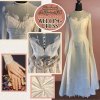 Wedd-Dress-Composite.jpg131.1 KB · Views: 187
Wedd-Dress-Composite.jpg131.1 KB · Views: 187 -
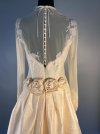 back-close-up1 copy 2.jpg114.3 KB · Views: 173
back-close-up1 copy 2.jpg114.3 KB · Views: 173 -
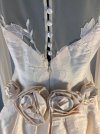 back-close-up2.JPG131.9 KB · Views: 135
back-close-up2.JPG131.9 KB · Views: 135 -
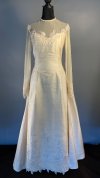 Front-full-view-1.JPG107.3 KB · Views: 141
Front-full-view-1.JPG107.3 KB · Views: 141 -
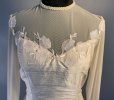 Front-lace-details.JPG106 KB · Views: 162
Front-lace-details.JPG106 KB · Views: 162 -
 8d271f0563ca12270df99c762fd64832.jpg92.6 KB · Views: 154
8d271f0563ca12270df99c762fd64832.jpg92.6 KB · Views: 154 -
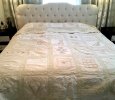 IMG_0698.JPG119.1 KB · Views: 150
IMG_0698.JPG119.1 KB · Views: 150 -
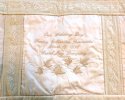 IMG_0699.JPG109.5 KB · Views: 141
IMG_0699.JPG109.5 KB · Views: 141 -
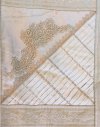 IMG_0706.JPG164 KB · Views: 139
IMG_0706.JPG164 KB · Views: 139 -
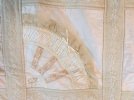 IMG_0702.JPG101.8 KB · Views: 153
IMG_0702.JPG101.8 KB · Views: 153 -
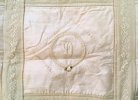 IMG_0701.JPG105.3 KB · Views: 129
IMG_0701.JPG105.3 KB · Views: 129 -
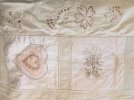 IMG_0704.JPG94.4 KB · Views: 173
IMG_0704.JPG94.4 KB · Views: 173